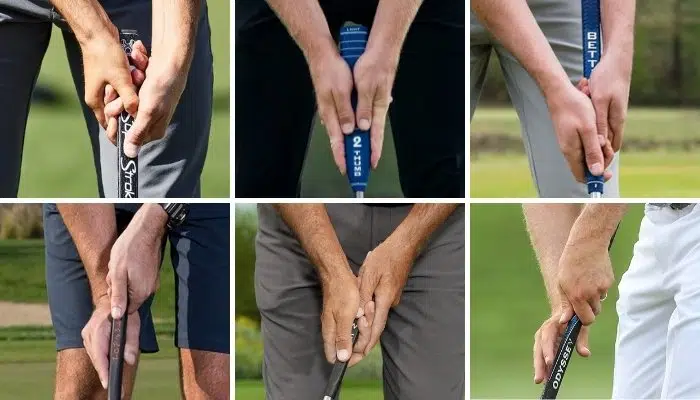Putting is one of the most important skills to master in the game of golf, and having a good grip technique is one of the key fundamentals to a smooth, reproduceable stroke.
In fact, between 35-40 percent of your total score each round will come on the greens with the flat stick in hand – it’s why the saying “drive for show, putt for dough” resonates with so many players.
If you can’t putt well, it’s unlikely you’ll ever reach a single figure handicap, or lower.
These days, there are so many putting grips to choose from – conventional, left-hand low, prayer, claw, arm lock, arm lock with claw or broomstick – and each have their advantages and disadvantages.
But which one is best? Well, the answer may not be as straight-forward as you would like it to be.
OTHER PUTTING ARTICLES YOU MIGHT LIKE:
- PUTTING ALIGNMENT: HOW TO LINE UP PUTTS
- 13 BEST INDOOR PUTTING GREENS TO HONE YOUR STROKE
- PUTTING WITH A GLOVE ON: SHOULD YOU DO IT?
Table of contents
Which putting grip/technique is best?
The best putting grip is one that is most comfortable for you. The most common technique used worldwide is the conventional grip (otherwise known as reverse overlap), but that does not mean it is the one you should use. The best putting grip is one that allows you to sink more putts – regardless of how you grip the club.
In a nutshell, there is no right or wrong putting grip – but each does have slight advantages and disadvantages that distinguish them from one another.
The 7 most common putting grips
Below, I’ll break down the seven most common putting grips used on the PGA Tour and list the pros and cons to help you decide which one is right for you.
Note: I’ll be describing each grip as if I were talking to right-handed players (sorry to all you lefties out there, you’ll just have to flip everything I say).
1. Conventional (Reverse Overlap)
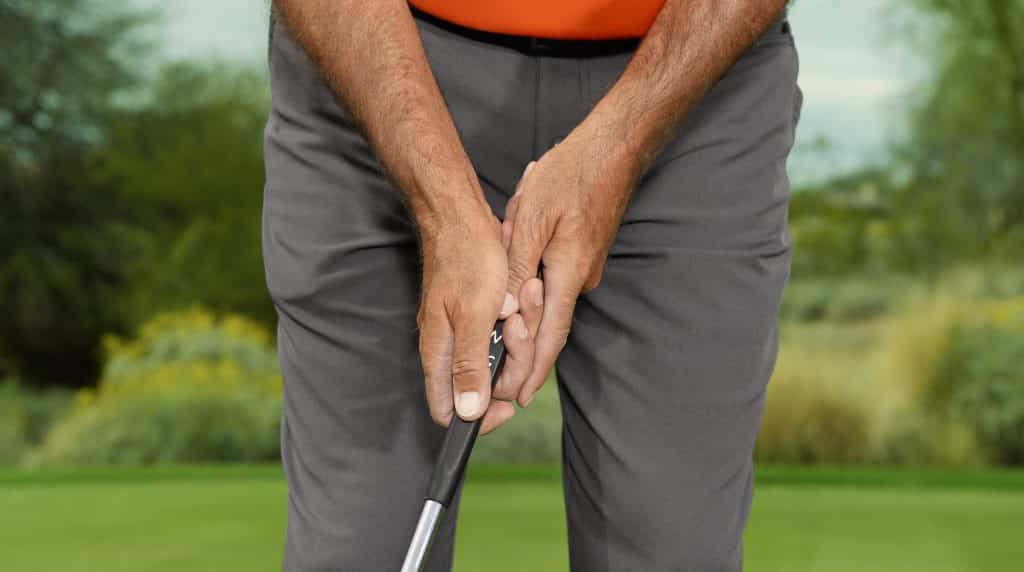
What is it?
The conventional grip, also known as the reverse overlap grip, is the most common technique used by professional golfers on the PGA Tour, and most famously used by 15-time major winner Tiger Woods.
This grip is a slight variation on the popular overlap version used when taking a full swing.
How does it work?
Take your right hand and place it at the bottom of the putter grip, making sure your thumb points straight down the shaft.
With your left hand, place your middle, ring and pinky fingers and wrap them around the back of the shaft, before placing your index finger over the fingers of your right hand that are already holding the club.
Advantages
One of the biggest advantages of the conventional grip is it helps to lock in your hands, and prevent excessive, unnecessary wrist hinge and clubface rotation in your putting stroke.
It’s also one of the most natural-feeling techniques, as both of your hands are used to grip the club.
Disadvantages
While it prevents overactive wrists, it doesn’t completely eliminate them.
Players who have a tendency to hinge their wrists to generate power in their stroke, rather than rocking their shoulders, may find the conventional grip produces inconsistent strikes.
If you are someone who struggles to keep your wrists quiet and stable while putting, this may not be the grip for you.
Who uses it?
Tiger Woods, Rory McIlroy, Jason Day.
TOP PUTTING TRAINING AIDS:
- PRO PATH GOLF PUTTING MIRROR
- PUTT-OUT GOLF PUTTING PLANE
- IXIA TRUE PENDULUM PUTTING FRAME
- PUTT-OUT PRESSURE PUTTING TRAINER
2. Left-Hand Low
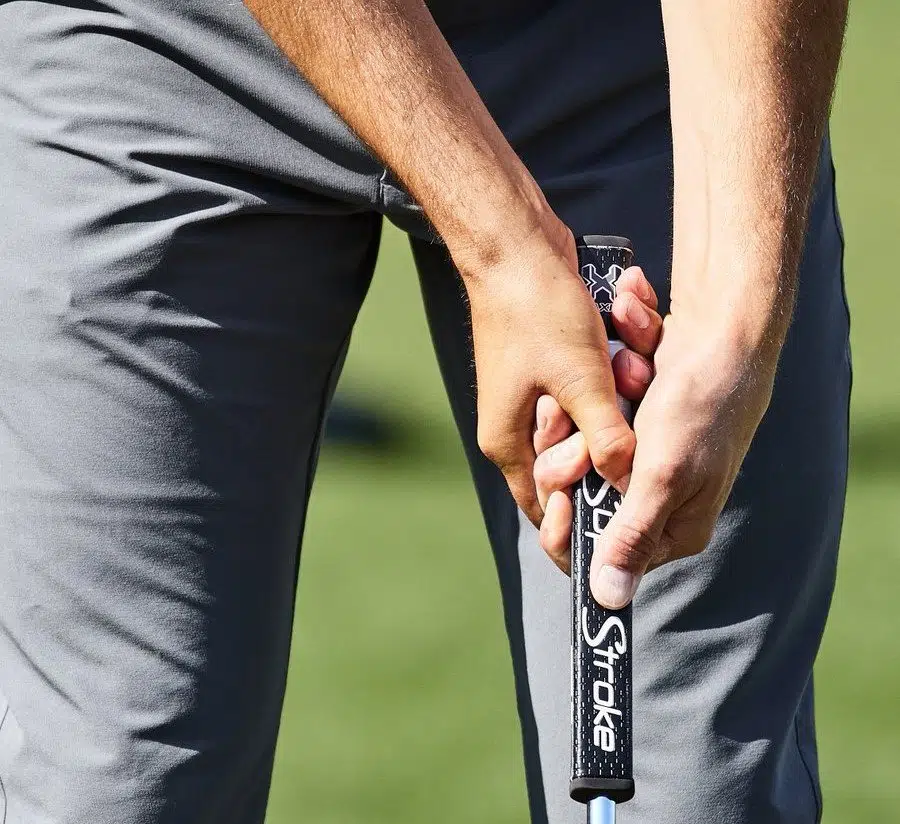
What is it?
The left-hand low grip is exactly as it sounds – the technique involves placing your left hand lower than your right hand on the handle.
In fact, 18-time major winner Jack Nicklaus said if he could go back and change just one thing about his game, it would be to learn to putt left-hand low (which is a big endorsement from one of the most clutch putters of all-time).
How does it work?
Start by placing the ridge of the putter grip in your left hand, with your wrist in a weak position (with the back of your hand facing your target) as this will limit rotational movement in the joint.
Your left thumb should be slightly on the left side of the shaft, rather than running down the centre.
Place your right hand above your left, and mirror the grip of your left hand (with your right wrist in a strong position).
Advantages
If you are a player who can’t stop flipping the club with your hands, or have overactive wrists, having your left hand low will prevent you from using too much right hand in your stroke.
You’ll find that the left hand, which is locked in place, will lead the club in the backswing and follow through and help you control speed and path with relative ease.
Disadvantages
If you’re someone who has used a conventional grip for some time, swapping to left-hand low can feel unnatural, and even weak (especially if your left hand is your non-dominant hand).
It may take a while to get used to the new sensation, and your results on the green may get worse initially before they get better.
Who uses it?
Jordan Spieth, Alex Noren, Dustin Johnson.
3. The Prayer
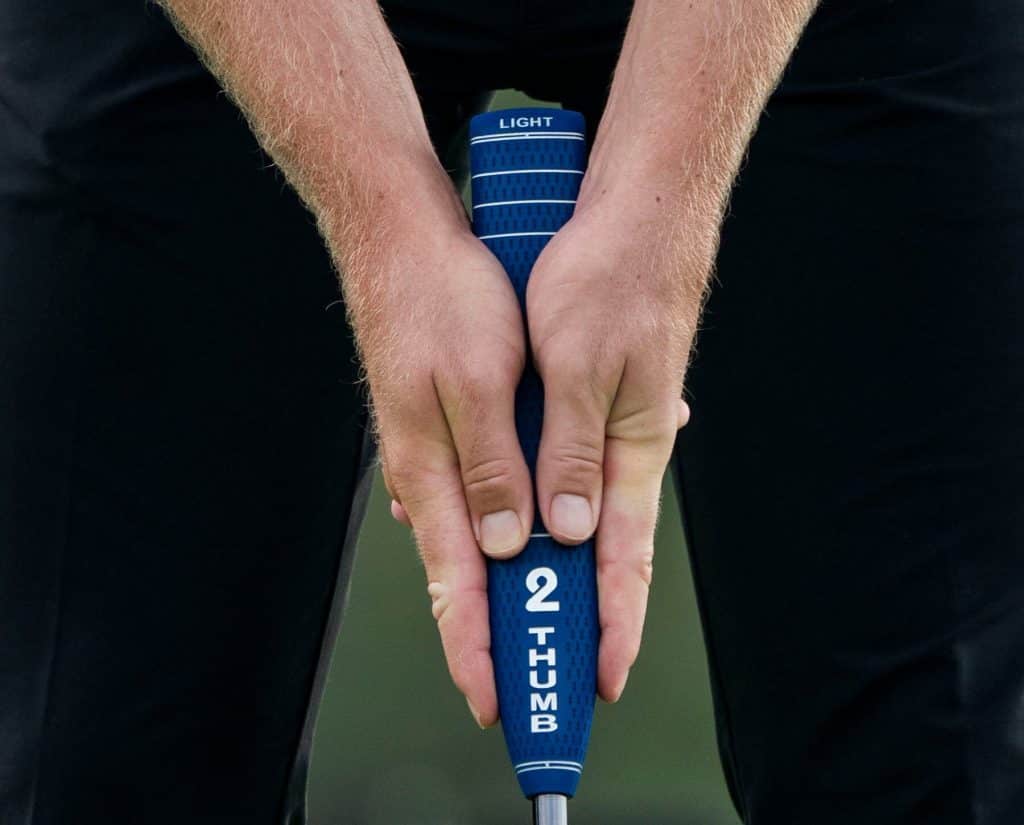
What is it?
The prayer grip is another putting technique that looks exactly as it sounds, and involves placing the hands symmetrically on either side of the grip as if you were preparing to say a prayer.
It is the only method where your hands grip the handle in an identical manner.
How does it work?
The prayer grip is one of the easiest to describe, and implement.
Simply rest the club upright and place your left palm on the left side of the putter grip, and your right palm on the right side.
Your hands should be in the centre of the grip, rather than too close to the top or bottom. Your thumbs should rest down the centre of the shaft.
You can choose to let your index fingers run down either side of the grip, or wrap them underneath.
When making a stoke, try and maintain the same distance between your elbows (which should be slightly bent) throughout the backswing and follow through.
Advantages
One of the biggest pros of the prayer grip is it promotes a smooth stroke, and stops you from choking the club by gripping it too tightly.
This reduction in tension can help remove any ‘jabby’ motions in your putting stroke.
The fact both of your hands are at the same level on the handle, rather than one higher and one lower, also promotes symmetry in your stroke, which can aid consistency.
Disadvantages
Every time I’ve tried using the prayer grip, I can’t help but feel like the putter is going to fall out of my hands (mainly because I’ve got small hands, and small fingers).
Not being able to wrap my hands completely around the putter handle, personally, feels less sturdy.
This grip may be better for players with larger hands, or those who use a thinner grip (unlike the chunky SuperStroke grip that I have on my putter).
Who uses it?
Matt Wallace, Paul Dunne.
4. The Claw
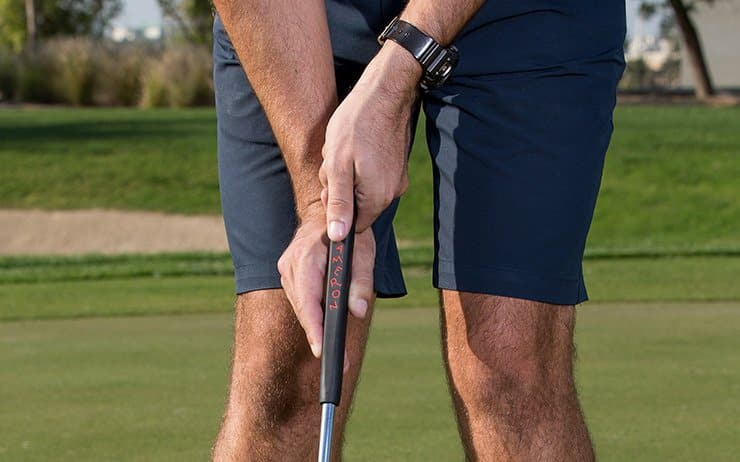
What is it?
The claw grip is an increasingly popular technique on the PGA Tour, and was used predominantly by golf legend Phil Mickelson during his historic 2021 PGA Championship victory.
It is very different to a conventional set-up and involves pinching the putter with little more than the fingertips on the right hand, in conjunction with a stable left hand.
How does it work?
Take your left hand and grip the putter at the top of the handle so that your thumb runs down the middle of the shaft.
Position your right hand underneath, so that the handle runs through the crevice between your index finger and thumb (as if it were a pencil).
Gently pinch the handle to complete the grip.
Advantages
The claw grip is perfect for golfers who have overactive hands and wrists, or struggle to control the club face throughout the stroke (either flaring it open, or closing it at impact, causing the ball to start offline).
The positioning of the hands in the claw-like manner limits the number of moving parts in the stroke, and helps keep the putter-face square.
Disadvantages
The claw grip may feel very unnatural if you’re someone who has made the swap from a conventional grip.
Similarly, if you’re someone who prefers to see the putter move on an arc in the swing (with the face opening and closing) rather than straight back and through, the claw grip may not suit you.
Who uses it?
Phil Mickelson, Tommy Fleetwood, Justin Rose.
5. Arm Lock
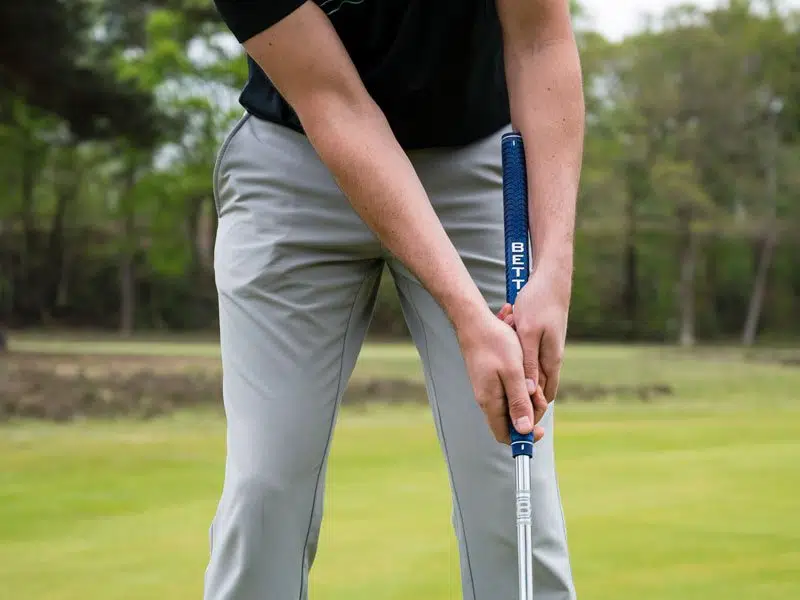
What is it?
The arm lock putting grip incorporates using a longer shaft than what is found on a traditional putter, which the player uses to brace their left arm against for greater stability.
How does it work?
The arm lock grip is virtually the same as a conventional (reverse overlap) grip, except with the left hand in a slightly weaker position so that the putter handle can run up the palm of the hand and press up against the left forearm.
You will feel as though there is some slight shaft lean forward in order to keep the forearm in contact with the handle.
Advantages
Bracing your left arm against the lengthier putter handle creates incredible stability and makes it extremely difficult to flip the clubface closed, or flare it open, as you strike the ball.
You only need to focus on taking the putter straight back and through on a nice line, and getting the pace right.
Disadvantages
Putting with an arm lock can remove a lot of the ‘feel’ that comes with using a conventional grip, and may add extra tension in your stroke as you attempt to keep the putter shaft pressed against your forearm.
You’ll also need to purchase a putter with a longer shaft in order to use this grip.
Who uses it?
Bryson DeChambeau, Matt Kuchar, Keegan Bradley.
6. Arm Lock With Claw
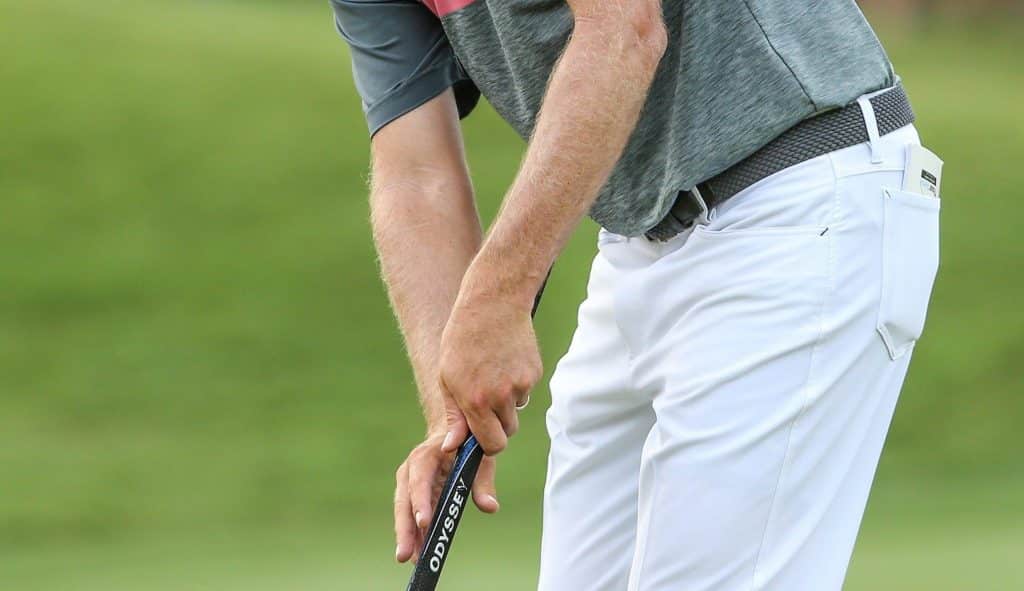
What is it?
This grip takes the arm lock and claw techniques and blends it together to create a seriously rigid, stable stroke that is almost robotic in nature.
It takes almost all of the right hand out of the stroke, and instead lets the left arm and hand do all the work (including determining speed and direction).
How does it work?
Simply grip the putter with your left hand as you would with an arm lock technique, ensuring the shaft is pressed snuggly against your left forearm.
To complete the grip, add your right thumb and index finger to the handle, below your left hand, just as you would with a traditional claw grip.
Advantages
It takes virtually all hand action out of the stroke, meaning the putter essentially becomes an extensive of your left arm.
The right hand has very little influence on speed or direction, and simply helps to stabilise the clubface.
Disadvantages
Because this is such an extreme method to use, it may take a long time getting used to.
Similarly, if you’re a player who likes feeling your hands (particularly your right hand) be a little more active during the stroke, this technique will probably feel awful to you.
Who uses it?
Webb Simpson.
7. Broomstick
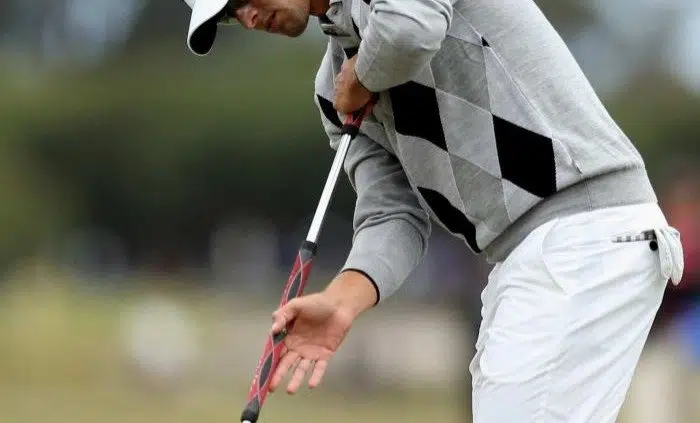
What is it?
Probably the least common technique used in modern golf, the broomstick putter – which is distinguishable by its trademark super-long handle – is becoming less popular since the PGA Tour outlawed players ‘anchoring’ the putter against their chest.
How does it work?
Taking your left hand, grip the top of the putter gently, keeping it in your fingertips rather than letting the handle sink too deeply into your palm.
With your right hand, you have some options to choose from – you can either grip the handle with your palm facing away from you (so that the shaft sits snuggly in there), or you can take a claw grip to ensure the right hand isn’t too dominant during the stroke.
Advantages
The broomstick method uses the big muscles in the body (such as the chest and shoulders) to do most of the work, which keeps your hands extremely passive.
It’s also great for players who may struggle or feel uncomfortable bending over into a conventional putting stance, or who prefer to stand tall while making their stroke.
Disadvantages
The bigger muscles used to move the broomstick putter are, naturally, extremely powerful so adjusting your speed control may take some time.
Similarly, carrying around a broomstick putter in your golf bag may be too annoying for an amateur golfer, and outweigh the advantages this technique offers.
Who uses it?
Adam Scott, Bernhard Langer.
How do I choose a putting grip?
The best way to decide which putting grip is for you is to experiment with all the different techniques to determine the one that feels most comfortable, and allows to your roll your putts with consistent speed control, and directional control. Each technique has its advantages and disadvantages, and there is no ‘right or wrong’ way to grip your putter.
What sized putter grip should I use?
The size of your putter grip comes down to personal preference. Thicker putter grips are said to prevent your hands being overactive during your stroke, however some players may find them uncomfortable compared to a thinner grip. Test out putters with different-sized grips – whether it’s your friend’s putter, or putters at your local golf shop – to decide what feels best for you.
Should I use a SuperStroke grip?
I currently use a SuperStroke putting grip and find it extremely comfortable to use. Personally, I like a thicker putting grip (like the SuperStroke) because it helps me create a fluent stroke, and stops my hands getting too active. I would certainly advocate testing out a SuperStroke grip, however it may feel unnatural if you’re used to using a thinner grip.
Should I wear a glove while putting?
Putting with or without a glove is completely up to you. Personally, I like putting with a glove on as it helps me grip the handle better. I explain the pros and cons of putting with a glove on in another article that I recommend you read.
Can you regrip your own putter?
If you’re looking to save a few bucks, you can regrip your own putter – all you’ll need is some grip solution, grip tape, your new grip, a grip removal tool and plenty of patience. There are heaps of tutorials on YouTube that you can follow to regrip your own putter, if you don’t want to take it in to a professional clubfitter.
I’ve never tried it myself, but it doesn’t look too hard and it’s unlikely you’ll do any permanent damage if you don’t get things quite right on the first attempt.
Final message
Deciding on which putting technique to use is a very personal decision that only you can make.
Test out all the different grip variations next time you’re out on the putting green, or having a casual social round with mates, and find out which one feels best for you.
Hopefully, you’ll be sinking more putts in no time!
- TaylorMade SIM2 Max Driver vs M4 Driver: Worth it in 2024? - April 15, 2024
- 3 Ways to Win the Mental Game with the Bridgestone Mindset Golf Ball - March 29, 2024
- TaylorMade SIM Max & SIM2 Max Drivers: Are they Still Relevant in 2024? - March 9, 2024

